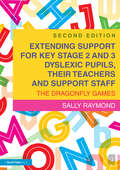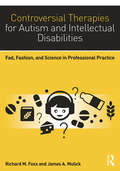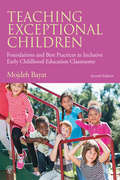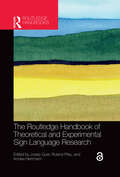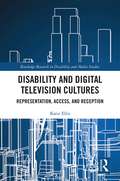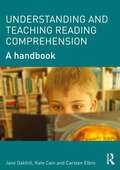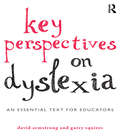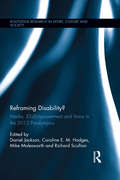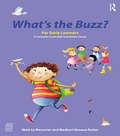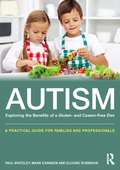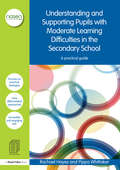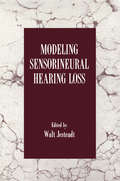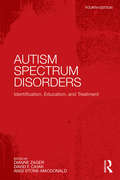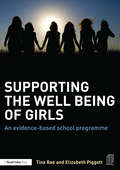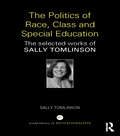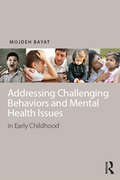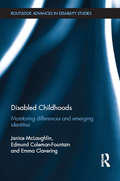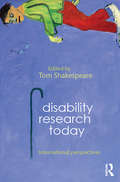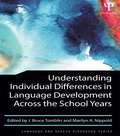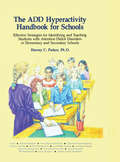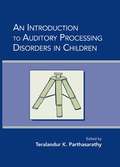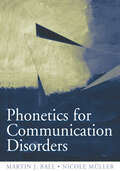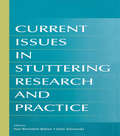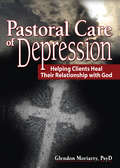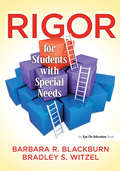- Table View
- List View
Extending Support for Key Stage 2 and 3 Dyslexic Pupils, their Teachers and Support Staff: The Dragonfly Games
by Sally Raymond"This isn't learning: this is fun!" - dyslexic pupil "Fantastic ideas that engage learners in their learning: thank you!" - Teaching Assistant "I like finding tactics which help me win!" dyslexic pupil "My son is now asking to play spelling games!" - parent "I like playing homework games with my dad." - dyslexic pupil "Its easy to adapt a game to suit different topics." Teacher "Things aren't so difficult now I know how to make hard things fun." dyslexic pupil Dragonfly Games is designed for use with small groups of dyslexic pupils. These practical and varied resources can be used inside and outside of the classroom to encourage over-learning and revision of curriculum topics. Stimulating and fun to do, the games help pupils: Overcome specific barriers to learning through the use of experience, over-learning and discovery Master skills beyond those of literacy and numeracy development, including thinking skills, tactical strategies, sequential application and gamesmanship. Devise their own games, developing their ability to use varied methods of application, useful for overcoming learning weaknesses within their own specific profile. . Fully updated in its second edition, this book builds on the success of the author’s Dragonfly Worksheets, as featured in her previous book Supporting Dyslexia Pupils Across the Curriculum and can be used independently or in conjunction this resource. Dragonfly Games further extends the practitioner's portfolio of materials designed to successfully and effectively support the dyslexic learner. Also available from this author Supporting Dyslexic Pupils Across the Curriculum, 2nd edition, 978-1-138-77462-9 Spelling Rules, Riddles and Remedies 978-0-415-71000-8
Controversial Therapies for Autism and Intellectual Disabilities: Fad, Fashion, and Science in Professional Practice
by James A. Mulick Richard M. FoxxOne of the largest and most complex human services systems in history has evolved to address the needs of people with autism and intellectual disabilities, yet important questions remain for many professionals, administrators, and parents. What approaches to early intervention, education, treatment, therapy, and remediation really help those with autism and other intellectual disabilities improve their functioning and adaptation? Alternatively, what approaches represent wastes of time, effort, and resources? <p><p>Controversial Therapies for Autism and Intellectual Disabilities, 2nd Edition brings together leading behavioral scientists and practitioners to shed much-needed light on the major controversies surrounding these questions. Expert authors review the origins, perpetuation, and resistance to scrutiny of questionable practices, and offer a clear rationale for appraising the quality of various services. <p><p>The second edition of Controversial Therapies for Autism and Intellectual Disabilities has been fully revised and updated and includes entirely new chapters on psychology fads, why applied behavioral analysis is not a fad, rapid prompting, relationship therapies, the gluten-free, casein-free diet, evidence based practices, state government regulation of behavioral treatment, teaching ethics, and a parents' primer for autism treatments.
Teaching Exceptional Children: Foundations and Best Practices in Inclusive Early Childhood Education Classrooms
by Mojdeh BayatTeaching Exceptional Children is an ideal textbook for introductory graduate and undergraduate courses on early childhood special education and teaching in inclusive classrooms. Bayat’s clear and accessible writing, a visually appealing design, and focused pedagogy in each chapter help make it possible to cover a significant amount of material. This powerful text identifies specific behavioral characteristics and presents theoretical information grounded in neuroscience and child development research for a wide range of disabilities. Research-based best practices for effectively working with children with various disabilities in inclusive classrooms are provided in each chapter. The second edition has been fully updated based on the DSM-5, and includes new sections on contemporary issues in inclusion of children with disabilities in early childhood classrooms, such as challenging behaviors, using technology, at-risk children, promoting mental health, and family issues. A robust pedagogical program, along with online resources for instructors and students, provides full support, including: Chapter Objectives and Key Terms help frame each chapter Discussion, Critical Thinking, Essay/Short Answer, and Review Questions at the beginning, throughout, and concluding chapters prompt students to fully engage with the material Homework/Field Assignments provide opportunities for students to apply their knowledge to real-world situations Real-Life Vignettes illustrate concepts in action Color Photos, Figures, and Tables clarify concepts in a visually engaging way Recommended Resources and References offer guidance for further study www.routledge.com/9781138802209 includes a link to an Instructor's Manual with ideas for assignments and projects, grading and assessment rubrics, and learning outcomes (see the e-Resource tab). A full companion website (www.routledge.com/cw/bayat) is under construction and will provide video and web links, discussion questions, test bank, PowerPoints, and a sample syllabus.
The Routledge Handbook of Theoretical and Experimental Sign Language Research (Routledge Handbooks in Linguistics)
by Josep QuerThe Routledge Handbook of Theoretical and Experimental Sign Language Research bridges the divide between theoretical and experimental approaches to provide an up-to-date survey of key topics in sign language research. With 29 chapters written by leading and emerging scholars from around the world, this Handbook covers the following key areas: On the theoretical side, all crucial aspects of sign language grammar studied within formal frameworks such as Generative Grammar; On the experimental side, theoretical accounts are supplemented by experimental evidence gained in psycho- and neurolinguistic studies; On the descriptive side, the main phenomena addressed in the reviewed scholarship are summarized in a way that is accessible to readers without previous knowledge of sign languages. Each chapter features an introduction, an overview of existing research, and a critical assessment of hypotheses and findings. The Routledge Handbook of Theoretical and Experimental Sign Language Research is key reading for all advanced students and researchers working at the intersection of sign language research, linguistics, psycholinguistics, and neurolinguistics.
Disability and Digital Television Cultures: Representation, Access, and Reception (Routledge Research in Disability and Media Studies)
by Katie EllisDisability and Digital Television Cultures offers an important addition to scholarly studies at the intersection of disability and media, examining disability in the context of digital television access, representation and reception. Television, as a central medium of communication, has marginalized people with disability through both representation on screen and the lack of accessibility to this medium. With accessibility options becoming available as television is switched to digital transmissions, audience research into television representations must include a corresponding consideration of access. This book provides a comprehensive and critical study of the way people with disability access and watch digital TV. International case studies and media reports are complimented by findings of a user-focused study into accessibility and representation captured during the Australian digital television switchover in 2013-2014. This book will provide a reliable, independent guide to fundamental shifts in media access while also offering insight from the disability community. It will be essential reading for researchers working on disability and media, as well as television, communications and culture; upper-level undergraduate and postgraduate students in cultural studies; along with general readers with an interest in disability and digital culture.
Understanding and Teaching Reading Comprehension: A handbook
by Jane Oakhill Kate Cain Carsten ElbroThe ultimate aim of reading is not the process but to understand what we read and comprehension can take place at many different levels. There has been an increasing emphasis on the importance of reading comprehension in recent years but despite this there is very little written on this vital topic accessible to trainee and practicing teachers. The Handbook of Reading Comprehension presents an overview of recent findings on reading comprehension and comprehension problems in children. It provides a detailed examination of the characteristics of children who have reading comprehension difficulties, and examines ways in which comprehension can be supported and improved. It is accessibly written for students and professionals with no previous background in the psychology of reading or reading problems. This indispensable handbook asks the question ‘what is comprehension?’ The authors consider comprehension of different units of language: understanding single words, sentences, and connected prose and outline what readers (and listeners) have to do to successfully understand an extended text. This book also considers comprehension for different purposes, in particular reading for pleasure and reading to learn and explores how reader characteristics such as interest and motivation can influence the comprehension process. Different skills contribute to successful reading comprehension. These include word reading ability, vocabulary knowledge, syntactic skills, memory, and discourse level skills such as the ability to make inferences, knowledge about text structure, and metacognitive skills. The authors discuss how each one contributes to the development of reading comprehension skill and how the development of these skills (or their precursors) in pre-readers, provides the foundation for reading comprehension development. Areas covered include:- Word reading and comprehension Development of comprehension skills Comprehension difficulties Assessment Teaching for improvement Throughout the text successful experimental and classroom based interventions will be highlighted, practical tips for teachers and summary boxes detailing key points and explaining technical terms will be included in each chapter
Key Perspectives on Dyslexia: An essential text for educators
by David Armstrong Garry SquiresThis indispensable book critically sets out the skills and knowledge required by a specialist educator for students who present with dyslexia. The British Dyslexia Association Professional Criteria (BDA, 2012) provides an anchor throughout for this book’s content. Chapters are explicitly mapped to specific professional criteria, offering the reader confidence that guidance in Key Perspectives on Dyslexia is underpinned by this internationally recognised professional framework.?? Key issues in the education and care of those affected by dyslexia are critically explained and explored in this publication, using both author’s years of specialist experience in this field. As established scholars both authors also suggest how research can inform and enrich how an educator responds to these issues.?? The content of this book includes: Detailed case studies disclosing how dyslexia presents in different individuals and which richly illuminate the issues considered by each chapter A concise examination of reading instruction in the context of typically-developing students and in relation to those who present with dyslexia: this incorporates an expert but accessible review of international policy and educational practice, including influential findings from research Detailed guidance on how to identify possible dyslexia and key issues to consider in referral and assessment of those affected, including associated models here such as Response to Intervention (RTI)? Consideration of intelligence and in how this figures in relation to assessment for dyslexia, including the possible role of intellectual disability (ID). Comprehensive evaluation of the role of behaviour in relation to dyslexia, with guidance on how this can be used to inform a programme of support for students with social, emotional or behavioural difficulties (EBD/SEBD). Consideration of how the professional role of a specialist educator might travel across the English speaking world and also beyond in China or India.?? Key Perspectives on Dyslexia is an essential text for educators and will become a landmark guide for educational practice and policy.???
Reframing Disability?: Media, (Dis)Empowerment, and Voice in the 2012 Paralympics (Routledge Research in Sport, Culture and Society #41)
by Daniel Jackson Caroline E.M. Hodges Mike Molesworth Richard ScullionThe London 2012 Paralympic Games - the biggest, most accessible and best-attended games in the Paralympics' 64-year history - came with an explicit aim to "transform the perception of disabled people in society," and use sport to contribute to "a better world for all people with a disability." This social agenda offered the potential to re-frame disability; to symbolically challenge "ableist" ideology and to offer a reinvention of the (dis)abled body and a redefinition of the possible. This edited collection investigates what has and is happening in relation to these ambitions. The book is structured around three key questions: 1. What were the predominant mediated narratives surrounding the Paralympics, and what are the associated meanings attached to them? 2. How were the Paralympics experienced by media audiences (both disabled and non-disabled)? 3. To what extent did the 2012 Paralympics inspire social change? Each section of this book is interspersed with authentic "voices" from outside academia: broadcasters, athletes and disabled schoolchildren.
What's the Buzz? For Early Learners: A complete social skills foundation course
by Mark Le Messurier Madhavi Nawana ParkerFor many, social thinking is hard-wired at birth and strengthens, quite naturally, through progressive experiences and encounters with others. However, for a variety of reasons, some children find it harder to think socially, develop socially and use their social tools suitably when it really counts. ‘What’s the Buzz?’ is the original social skills programme and became an instant best-seller, used by practitioners around the globe with children and young people, helping them to successfully transfer these skills into their everyday lives. What’s the Buzz? For Early Learners : is a simple, structured programmes to teach students in early learning and early primary school settings, within the 4 to 7 year age range. is designed to bring children together, including those who may be on the autistic spectrum explicitly demonstrates methods of how children can get along with one another and nurture friendship groups. Uses a developmental model to ensure its relevance throughout By drawing on the modelling of targeted social skills, role play, explicit guidance, feedback and games, this resource is imaginative, very practical and is enhanced with visual materials and worksheets to accompany each lesson. http://www.whatsthebuzz.net.au Also available from Routledge: Mark Le Messurier and Madhavi Nawana Parker (2011) What’s the Buzz: A Social Skills Enrichment Programme for Primary Students
Autism: A practical guide for families and professionals
by Paul Whiteley Mark Earnden Elouise RobinsonAutism represents one of the biggest health challenges facing children today. Whilst experts around the globe strive to unravel and truly understand how autism develops and presents itself, relatively little is still known about the condition. Meanwhile, strong evidence has emerged that the diet in children on the autistic spectrum can have a significant role to play in the management of their symptoms. A growing body of research reveals that some challenging characteristics present in autism may be positively affected by the introduction of a gluten- and casein-free (GFCF) diet. Autism: Exploring the benefits of a gluten and casein free diet offers an easy-to-read alternative to sifting through the science. Written by experts in autism research, food, nutrition and dietetics, the book cuts through the science-speak to offer readers a no-nonsense overview of diet and autism together with a range of useful recipes and handy hints for making mealtimes fun for children with autism and related conditions.
Understanding and Supporting Pupils with Moderate Learning Difficulties in the Secondary School: A practical guide (nasen spotlight)
by Rachael Hayes Pippa WhittakerAre you working with students who have Moderate Learning Difficulties? Do you want to know how best to help them? Are you confused about what helps and what hinders? Learners with MLD form one of the largest categories of special educational need in mainstream secondary schools. In most schools, the vast majority of learners with MLD will be taught in mainstream classes much of the time. This book outlines a range of strategies and approaches for supporting these learners. It includes all the vital information practitioners need to know about Moderate Learning Difficulties. Key points covered include: Definitions and identification of moderate learning difficulties Teaching strategies and approaches Developing key conceptual, literacy and social skills Effective support from TAs Theoretical perspectives on learning Understanding and Supporting Pupils with Moderate Learning Difficulties in the Secondary School provides an introduction to a wide range of ideas, arguments and perspectives about ways of understanding and supporting learners who are considered to have MLD. This is a much-needed source of knowledge for teachers, TAs, SENCos, Learning Mentors and anyone who supports children and young people with moderate learning difficulties and provides an honest and accessible approach.
Modeling Sensorineural Hearing Loss
by Walt JesteadtA recent study indicates that 20 million people in the United States have significant sensorineural hearing loss. Approximately 95% of those people have partial losses, with varying degrees of residual hearing. These percentages are similar in other developed countries. What changes in the function of the cochlea or inner ear cause such losses? What does the world sound like to the 19 million people with residual hearing? How should we transform sounds to correct for the hearing loss and maximize restoration of normal hearing? Answers to such questions require detailed models of the way that sounds are processed by the nervous system, both for listeners with normal hearing and for those with sensorineural hearing loss. This book contains chapters describing the work of 25 different research groups. A great deal of research in recent years has been aimed at obtaining a better physiological description of the altered processes that cause sensorineural hearing loss and a better understanding of transformations that occur in the perception of those sounds that are sufficiently intense that they can still be heard. Efforts to understand these changes in function have lead to a better understanding of normal function as well. This research has been based on rigorous mathematical models, computer simulations of mechanical and physiological processes, and signal processing simulations of the altered perceptual experience of listeners with sensorineural hearing loss. This book provides examples of all these approaches to modeling sensorineural hearing loss and a summary of the latest research in the field.
Autism Spectrum Disorders: Identification, Education, and Treatment
by Angi Stone-Macdonald David F. Cihak Dianne ZagerThe field of autism has been growing at an unprecedented rate in recent years. In addition to an actual rise in the number of classic DSM-IV cases, broadened diagnostic criteria have uncovered a wider range of autistic behaviors and ability levels. The third edition of this well-known text continues the mission of its predecessors--to present a comprehensive, readable, up-to-date overview of the field of autism, one that links research, theory, and practice in ways that are accessible to both practitioners and parents. Key features include:*Expanded Coverage--To accommodate the recent explosion of research, the book has been expanded from 11 to 14 chapters that examine the impact of autism on the individual and the family from infancy through adulthood.*Expertise--Internationally recognized experts offer cutting-edge treatment and educational information on topics such as early diagnosis, medical treatment, assessment, educational methods, language development, behavior regulation, and family support.*Neurobiological Research--Comprehensive medical research and treatment chapters provide an understandable overview of neurobiological research and current treatments including when and how medication can be employed as part of a treatment plan.*Focus on Early Years--Old sections I and III have been combined and a new 3-chapter section on early identification and intervention added.*Focus on Parents and Families--In addition to a chapter on the evolving role of families, a new chapter addresses family needs during the preschool years.*Integration of Assessment and Intervention--The chapters on assessment and intervention have been reorganized and more closely integrated in keeping with current thinking about their inter-relatedness.*Future Directions--Two chapters discuss emerging directions in this exploding field and how to make informed decisions among a variety of approaches.This book is appropriate for anyone--students, practitioners, or parents--who must provide care for an autistic child.
Supporting the Well Being of Girls: An evidence-based school programme
by Tina Rae Elizabeth PiggottSupporting the Well being of Girls will provide teachers, psychologists, youth workers and learning mentors with an evidence based approach to the vitally important task of supporting and maintaining the well being of girls. This tried and tested programme offers teachers in upper primary and secondary schools sixteen tailored, expert sessions which engage girls and young women in tackling and addressing some of their key concerns and issues. Written by hugely experienced educational psychologists, the sessions utilise tools and strategies from a range of therapeutic interventions including cognitive behavioural therapy and positive psychology to provide a safe and nurturing environment in which to consider some sensitive issues and ultimately providing young women with the strength and self awareness to maintain overall well-being. Areas covered include:- • Body image and appearance• Bullying• Mental health, anxiety and depression• Relationships• Stereotypes• Self-harm• Stress• Healthy Living Throughout, clear guidance is offered to teachers on running sessions including, welcome and ground rules, talk time and inviting students to share experiences, ice-breakers, activities and feedback. This programme of support also includes a full range of support tools for the school including:- • Information sheet for students• Information sheet for parents• Letter to parents• Mental health fact sheet• Referral routes to specialist agencies• Mental health agencies – contact details• Policy for schools on developing mental health work
The Politics of Race, Class and Special Education: The selected works of Sally Tomlinson
by Sally TomlinsonIn the World Library of Educationalists series, international experts themselves compile career-long collections of what they judge to be their finest pieces – extracts from books, key articles, salient research findings, major theoretical and practical contributions – so the world can read them in a single manageable volume. Readers will be able to follow the themes and strands and see how their work contributes to the development of the field. Professor Sally Tomlinson brings together 12 of her key writings in one place, including chapters from her best-selling books and articles from leading journals. In this landmark publication she reviews and recounts the history and development of her research and writing over 30 years that is concerned with the politics of education systems, especially special education, and the place of social classes and ethnic and racial minorities in the systems. Social class, race and gender have historically always been essential markers in deciding who would receive a minimum or inferior education and thus fail to obtain whatever were currently acceptable qualifications. Definitions of the ‘less able’ or ineducable were based on beliefs in the biological and cultural inferiority of lower social classes, racial and immigrant groups. Professor Tomlinson’s aim in her work has always been to introduce sociological, historical and political perspectives into an area dominated by psychological, administrative and technical views and to explain how the individual ‘problems’ were connected to wider social structures and policies. This unique collection illustrates the development of Professor Tomlinson’s thinking over the course of her long and esteemed career.
Addressing Challenging Behaviors and Mental Health Issues in Early Childhood
by Mojdeh BayatA copublication with the Council for Exceptional Children (CEC), Addressing Challenging Behaviors and Mental Health Issues in Early Childhood focuses on research-based strategies for educators to address challenging behaviors of children during early childhood and elementary school years. Utilizing research from the fields of neuroscience, child development, child psychiatry, counselling and applied behavior analysis, the author suggests simple strategies for teachers to manage behaviors and promote mental health and resilience in children with challenging behaviors. Addressing Challenging Behaviors and Mental Health Issues in Early Childhood provides a framework for best practices which are empirically based and have been successfully utilized in the classroom. An appreciation of the deep understanding of culture as it affects curricular approaches, family engagement, and child growth and development is utilized throughout this comprehensive, multidisciplinary resource. Bayat references the most recent research in the field of child mental health and provides educational and intervention approaches that are appropriate for all children with and without disabilities.
Disabled Childhoods: Monitoring Differences and Emerging Identities (Routledge Advances in Disability Studies)
by Janice McLaughlin Edmund Coleman-Fountain Emma ClaveringA crucial contemporary dynamic around children and young people in the Global North is the multiple ways that have emerged to monitor their development, behaviour and character. In particular disabled children or children with unusual developmental patterns can find themselves surrounded by multiple practices through which they are examined. This rich book draws on a wide range of qualitative research to look at how disabled children have been cared for, treated and categorised. Narrative and longitudinal interviews with children and their families, along with stories and images they have produced and notes from observations of different spaces in their lives – medical consultation rooms, cafes and leisure centres, homes, classrooms and playgrounds amongst others – all make a contribution. Bringing this wealth of empirical data together with conceptual ideas from disability studies, sociology of the body, childhood studies, symbolic interactionism and feminist critical theory, the authors explore the multiple ways in which monitoring occurs within childhood disability and its social effects. Their discussion includes examining the dynamics of differentiation via medicine, social interaction, and embodiment and the multiple actors – including children and young people themselves – involved. The book also investigates the practices that differentiate children into different categories and what this means for notions of normality, integration, belonging and citizenship. Scrutinising the multiple forms of monitoring around disabled children and the consequences they generate for how we think about childhood and what is ‘normal’, this volume sits at the intersection of disability studies and childhood studies.
Disability Research Today: International Perspectives
by Tom ShakespeareGrouped around four central themes – illness and impairment, disabling processes, care and control, and communication and representations – this collection offers a fresh perspective on disability research, showing how theory and data can be brought together in new and exciting ways. Disability Research Today starts by showing how engaging with issues around illness and impairment is vital to a multidisciplinary understanding of disability as a social process. The second section explores factors that affect disabled people, such as homelessness, violence and unemployment. The third section turns to social care, and how disabled people are prevented from living with independence and dignity. Finally, the last section examines how different imagery and technology impacts our understandings of disability and deafness. Showcasing empirical work from a range of countries, including Japan, Norway, Italy, Australia, India, the UK, Turkey, Finland and Iceland, this collection shows how disability studies can be simultaneously sophisticated, accessible and policy-relevant. Disability Research Today is suitable for students and researchers in disability studies, sociology, social policy, social work, nursing and health studies.
Understanding Individual Differences in Language Development Across the School Years
by J. Bruce Tomblin Marilyn A. NippoldThis volume presents the findings of a large-scale study of individual differences in spoken (and heard) language development during the school years. The goal of the study was to investigate the degree to which language abilities at school entry were stable over time and influential in the child’s overall success in important aspects of development. The methodology was a longitudinal study of over 600 children in the US Midwest during a 10-year period. The language skills of these children -- along with reading, academic, and psychosocial outcomes -- were measured. There was intentional oversampling of children with poor language ability without being associated with other developmental or sensory disorders. Furthermore, these children could be sub-grouped based on their nonverbal abilities, such that one group represents children with specific language impairment (SLI), and the other group with nonspecific language impairment (NLI) represents poor language along with depressed nonverbal abilities. Throughout the book, the authors consider whether these distinctions are supported by evidence obtained in this study and which aspects of development are impacted by poor language ability. Data are provided that allow conclusions to be made regarding the level of risk associated with different degrees of poor language and whether this risk should be viewed as lying on a continuum. The volume will appeal to researchers and professionals with an interest in children’s language development, particularly those working with children who have a range of language impairments. This includes Speech and Language Pathologists; Child Neuropsychologists; Clinical Psychologists working in Education, as well as Psycholinguists and Developmental Psychologists.
The ADD Hyperactivity Handbook For Schools
by Harvey C. ParkerIf you've ever wanted to take dynamic and vibrant digital photos of your favorite band in concert, but aren't sure how to tackle such obstacles as approaching the stage, tricky lighting situations, or even what equipment to use, then look no further!Concert and Live Music Photographyis a comprehensive guide to shooting live music performances, providing you with the right information on equipment, camera settings, composition, and post-processing to get the best out of each performance shot. J. Dennis Thomas, whose work has appeared in such magazines as Rolling Stone, SPIN, and Country Weekly, shares tips on lighting, common problems, etiquette, and recommended camera settings for shooting in a variety of different venues, including clubs, bars, outdoor concerts, theatres, stadiums, and arenas. He also explains how to get the right credentials to get you closer to each performance.Jam packed with over160 photos from today's top concerts, this book will not only give you the information you need to start taking rockin' photos of your favorite musicians, but will spark your creativity when you're anticipating the next shot.For the on-the-go photographer, a cool companion website features additional tips, venue troubleshooting, and an equipment checklist when you need to think on your feet while running to another gig.
An Introduction to Auditory Processing Disorders in Children
by Teralandur K. ParthasarathyAuditory processing in children (APD) comprises an increasingly important clinical area within the broad field of communication disorders. This new textbook presents the major advances in the assessment and management of APD. The chapter authors, highly regarded clinicians and researchers from diverse professional groups, contribute an impressive breadth of knowledge to explain and demystify APD. This text will be useful to students of speech language pathology and audiology, as well as professionals in those fields.
Phonetics for Communication Disorders
by Martin J. Ball Nicole MullerThis comprehensive textbook offers a basic introduction to phonetics in an applied systematic presentation that equips the communication disorders student to deal with the wide range of speech types that will be encountered in a clinic. While the major discussion is articulatory, speech acoustics are also examined. Illustrations of sample spectrograms appear in tandem with the more traditional articulatory drawings. Two CDs of sound examples accompany the textbook. This comprehensive textbook offers a basic introduction to phonetics in an applied systematic presentation that equips the communication disorders student to deal with the wide range of speech types that will be encountered in a clinic. While the major discussion is articulatory, speech acoustics
Current Issues in Stuttering Research and Practice
by Nan Bernstein Ratner John TetnowskiThis state-of-the art volume is a follow-up to the 1999 publication, Stuttering Research and Practice: Bridging the Gap, edited by Nan Ratner and E. Charles Healey. Like its predecessor, the current book is an edited collection of the presentations from the American Speech-Language-Hearing Association’s Annual Leadership Conference in Fluency and Fluency Disorders. Among the topics covered are evidence-based practice, impact of the self-help and support groups, meta-analyses of selected assessment and intervention programs, current theories of stuttering, and the predicted path of stuttering intervention in the future. The authoritative representation of contributors offers the reader the most up to date presentation of fluency issues, with a special emphasis placed on the practical clinical implications of fluency assessment, treatment, and evolving theories of the disorder. The book is written for fluency specialists and graduate students in programs of fluency disorders. It will also be valuable for the clinicians who wish to upgrade their skills in treating fluency disorders.
Pastoral Care of Depression: Helping Clients Heal Their Relationship with God
by Glendon MoriartyThis book provides the essential tools needed to transform negative God images in depressed clients! Pastoral Care of Depression: Helping Clients Heal Their Relationship with God is designed to help clergy and mental health professionals understand how depression negatively affects the way people emotionally experience God and how, through therapy, this hurtful God image can be changed into a much more positive one focused on healing.In the past, the God image (as well as the essential differentiation between God image and God concept) has been explained in dull, analytic terms that are difficult to understand. This book&’s jargon-free language and engaging presentation make it an effective learning tool for students and professionals alike. Inside, you&’ll find numerous psychological tests, complete with sample test forms, that identify the God image. These are clearly explained and include all the information needed to take, administer, and interpret them. Pastoral Care of Depression teaches you to use psychodynamic and cognitive interventions to change a client&’s God image, including foundational knowledge and clearly presented techniques to implement in the therapeutic relationship. This comprehensive treatment manual arms you with the most comprehensive array of cognitive interventions published to date, with tens of easy-to-follow techniques designed to tap directly into an individual&’s subjective experience of God. Two appendixes give you a sample God Image Automatic Thought Record and Treatment Plan form.Part I: Depression and the God Image examines: the nature and development of depression symptoms of depression specific to religious people defining a client&’s image of God, how it developed, and what it reveals the relationship between self, depression, and God image, and how God images relate to Christian thoughtPart II: Changing the God Image addresses: the importance of self-evaluation for therapists and counselors-and how to do it the nature of the therapeutic relationship counseling skills that strengthen the therapeutic relationship how to conduct an God Image Assessment Interview and how to work with what that interview reveals transference, countertransference, cyclical maladaptive patterns, and internalization in psychodynamic psychotherapy appropriate, effective psychodynamic interventions the essentials of cognitive therapy and how it can be utilized to positively affect the God image treatment planning and case conceptualization important ethical issues for considerationWith well-designed test and exercise forms and clear instructions on their use and interpretation, Pastoral Care of Depression provides the essential tools needed to work effectively with this important client group. Make it a part of your professional/teaching collection today!
Rigor for Students with Special Needs
by Barbara R. Blackburn Bradley S. WitzelThis practical, easy-to-read guide explains how to raise the rigor for students with special needs so they can achieve higher levels of learning. Learn how to set clear goals and expectations establish a climate of success scaffold and model lessons use graphic organizers and "think-alouds" apply modifications and accommodations use rigorous questioning strategies differentiate instruction increase family involvement Get even more out of this book by discussing it with others! It’s ideal for study groups and the appendix features a detailed guide on how to make it work for your group! Bonus! You get a great variety of handy black line masters for use in your own classroom.
